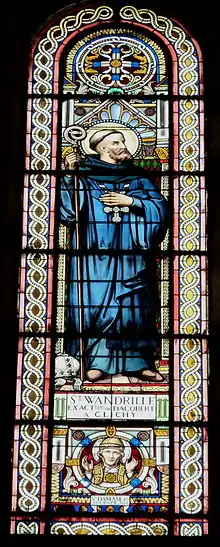Wandregisel
Saint Wandregisel (French: Wandrille) (c. 605–668 AD) was a Frankish courtier, monk, and abbot.[1]
Saint Wandregisel | |
|---|---|
 St.Wandregisel, Church of St. Vincent-de-Paul, Clichy | |
| Abbot | |
| Born | c. 600 AD near Verdun |
| Died | 668 AD |
| Venerated in | Roman Catholic Church |
| Feast | July 22 |
Life
The son of Walchisus, a kinsman of Pepin of Landen,[2] he was born around 605, near Verdun in the region then known as Austrasia. He was educated at the Frankish court in Metz.
Wandregisel was part of a group of young courtiers Audoin and Didier of Cahors who served Dagobert I, but in 629 he retired from court to become a monk at Montfaucon under the guidance of Saint Balderic. Wandregisel had received the tonsure without the permission normally required for a courtier, and was summoned to court to explain this apparent oversight. Dagobert then approve his request.[3]
Wandregisel soon withdrew to live as a hermit in complete solitude at Saint-Ursanne in the Jura.[2] Wandregisel adhered to the principles of Columbanus and his disciple Saint Ursicinus, both of whom had founded several monasteries in the region. In 635 Wandregisel spent some time at the monastery of Saint Columban at Bobbio in northern Italy.[1] From there, he wished to travel to Ireland,[4] but by 642 got only as far as the abbey of Romainmôtier,[5] which lay on the banks of the Isère River, in the Tarentaise Valley.
Wandregisel was ordained, and then founded Fontenelle Abbey in Normandy,[1] on land obtained from Erchinoald through the influence of his friend Archbishop Audoin of Rouen. Fontenelle followed the rule of Saint Columbanus, and the abbey became an important center of learning. Near the abbey's ruins lies the village of Saint-Wandrille-Rançon.
Wandregisel died on July 22, 668.[6]
Veneration
During the Viking invasions, Wandregisel's relics were dispersed to various locations and shared between various churches, including the abbey of Saint-Pierre-au-Mont-Blandin in Ghent (now in Belgium). Wandregisel's cult was celebrated in England prior to the Norman Conquest of 1066.[1]
In the 19th century one of his relics remained: his skull was found in Liège. It was brought back to the Abbey, when the new church was dedicated in 1967. It can be seen today in a modern reliquary.
References
- Arduino, Fabio (June 18, 2006). "San Vandregisilo" (in Italian). Santi e Beati. Retrieved February 7, 2009.
- Baring-Gould, Sabine (1882). The Lives of the Saints. 2. London: John Hodges. pp. 515–517.
- Kreiner, Jamie. The Social Life of Hagiography in the Merovingian Kingdom, Cambridge University Press, 2014, ISBN 9781139917032, p. 67
- Schäfer, Joachim. "Wandregisil (Wandrille, Wando)". Ökumenisches Heiligenlexikon (in German). Retrieved January 27, 2010.
- Fox, Yaniv. Power and Religion in Merovingian Gaul, Cambridge University Press, 2014 ISBN 9781316061749
- Mann, Ansgar Wilder. "Wandregisel", Historical Dictionary of Switzerland, Bern
Primary sources
- Miracula Sancti Wandregisili abbatis Fontanellensis. In Acta Sanctorum 32 (July 5). Paris: Victor Palmé, 1868. 281–91.
- Translatio Sancti Wandregisili in montem Blandinium In Acta Sanctorum 32 (July 5). 291–302.
- Vita Sancti Wandregisili abbatis Fontanellensis I . In Acta Sanctorum 32 (July 5). 265–71.
- Vita Sancti Wandregisili abbatis Fontanellensis II. In Acta Sanctorum 32 (July 5). 272–81.
- Vita Wandregiseli abbatis Fontanellensis, ed. B. Krusch. In Passiones vitaeque sanctorum aevi Merovingici 3, ed. Wilhelm Levison, 1-24. MGH SS rer. Merov. 5. Hanover, 1910. 1-24. Available from the Digital MGH.
